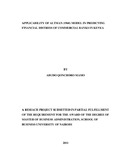| dc.contributor.author | Mamo, Abudo Q | |
| dc.date.accessioned | 2013-03-01T06:35:17Z | |
| dc.date.issued | 2011 | |
| dc.identifier.citation | MBA Thesis | en |
| dc.identifier.uri | http://erepository.uonbi.ac.ke:8080/xmlui/handle/123456789/12760 | |
| dc.description.abstract | The study basically determines how financial distress can be predicted in banking industry using Altman(1968) model. Many corporate are faced with financial inefficiency and are not in position to correctly predict their position in short or long term. There is a dire need for prediction of business failures since the results of business failure leads to heavy losses both financially and non-financially.
The economic cost of business failures is relatively large. Evidence shows that the market value of the distressed firms declines substantially. The cost of bank failures is very difficult to estimate much of the data is not in the public domain, while the eventual cost to depositors and/or taxpayers of most of the bank failures which occurred will depend upon how much of the failed banks’ assets are eventually recovered by the liquidators. The cost are almost certain to be substantial. The biggest contributor to the bad loans, poor management and political interferences of many of the failed local banks was insider lending. In at least half of the bank failures in Kenya a substantial proportion of the bad debts accounted for. Today bankruptcies, seizures and foreclosures are more than extra.
The methodology utilized examined and justified the research design to be applied in the study. It also stated the population of interest for the study and the sample to be used. The data collection method relied on 43 commercial banks identified under the population of the study. From the data each company and each year the ratio was computed. The data analysis technique applied discriminate failed versus non failed ones and the justification for its use is also given. The source of Secondary data is obtained from financial reports and prudential returns filed with Central bank of Kenya supervision department.
Edward Altman’s financial distress prediction model is found to be accurate on 8 out of the 10 failed firms, 80 % validity for the model and on sampled for non failed majority proved Altman’s financial distress prediction model was a 90% validity of the model. The objectives of this study were to determine relevance of a discriminate model to predict financial distress. | en |
| dc.description.sponsorship | University of Nairobi | en |
| dc.language.iso | en | en |
| dc.subject | Altman model (1968) | en |
| dc.subject | Financial Distress | en |
| dc.subject | Commercial banks | en |
| dc.subject | Kenya | en |
| dc.title | Applicability of Altman (1968) model in predicting financial distress of commercial banks in Kenya | en |
| dc.type | Thesis | en |
| local.embargo.terms | 6 months | en |
| local.publisher | School of Business, University of Nairobi | en |

